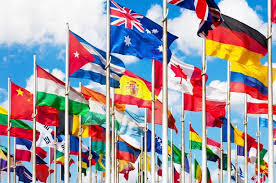Cultivating Global Unity: A Collaborative Path to Peace and Understanding
The escalating interconnectedness of our globalized world necessitates a paradigm shift towards global cooperation, transcending the merely aspirational and becoming a critical imperative for navigating complex socio-economic and environmental challenges. This necessitates a unified global response, demanding a concerted effort to foster empathy, celebrate diversity, and collaboratively pursue shared objectives. Achieving a harmonious global society requires a multifaceted approach, as elaborated in the following strategies grounded in relevant theoretical frameworks.
1. Promoting Global Equity and Collaborative Governance: This strategy aligns with Rawls's Theory of Justice, advocating for equitable access to resources (healthcare, education, economic opportunities) irrespective of nationality or background. Addressing global inequalities, a core tenet of distributive justice, is crucial for fostering unity and building a just world order. Furthermore, the application of collaborative governance models, emphasizing multi-stakeholder partnerships between governments, organizations, and civil society, facilitates the achievement of shared goals (e.g., poverty reduction, environmental sustainability) – a key principle of effective collective action. Real-world examples include the Sustainable Development Goals (SDGs), showcasing collaborative efforts towards global challenges.
2. Bridging Cultural Divides Through Intercultural Dialogue and Education: This strategy draws upon theories of intercultural communication and conflict resolution. Meaningful cross-cultural dialogue, facilitated by exchange programs and initiatives promoting mutual understanding, dismantles cultural barriers. Employing a constructivist approach to education, actively challenging personal biases and fostering critical engagement with diverse cultures, religions, and ideologies is crucial. This approach promotes tolerance and dismantles preconceived notions, facilitating the development of a more inclusive and understanding global community. Successful examples include the implementation of multicultural education programs in schools and universities.
3. Leveraging Technology for Global Connectivity and Peacebuilding: This leverages the principles of network theory and the diffusion of innovation. Harnessing technology (social media, online platforms) connects individuals globally, fostering dialogue and promoting understanding. This creates interconnected networks that facilitate the dissemination of information and promote collaborative problem-solving. The concept of "global village" is realized through technological advancements, enabling rapid information exchange and fostering empathy by showcasing diverse perspectives. Examples include online peacebuilding initiatives and digital diplomacy.
4. Empowering Grassroots Initiatives and Fostering a Shared Global Identity: This aligns with community-based participatory research and social identity theory. Supporting grassroots initiatives that promote dialogue and unity recognizes their transformative potential in fostering local ownership and engagement. Highlighting shared values (peace, well-being) strengthens our collective identity and purpose, promoting a sense of global citizenship. Successful examples include locally-led peacebuilding efforts and community-based environmental initiatives.
5. Promoting Peaceful Conflict Resolution and Environmental Stewardship: This strategy is underpinned by conflict resolution theory and environmental ethics. Advocating for peaceful conflict resolution mechanisms (dialogue, negotiation, mediation) prevents violence and fosters stability, aligning with restorative justice principles. Recognizing the interconnectedness of environmental issues and global security requires promoting sustainable practices and policies to combat climate change, crucial for ensuring a livable future for all. Examples range from international environmental agreements to local community-based conservation projects.
6. Cultivating Empathy and Inclusive Leadership Through Intergenerational Dialogue: This strategy incorporates principles of social learning theory and leadership studies. Meaningful intergenerational dialogue, acknowledging generational perspectives, enhances understanding and collaboration. Promoting diverse leadership (gender equality, racial diversity, inclusion of marginalized groups) builds belonging and unity, enhancing the effectiveness and legitimacy of global governance structures. Successful examples include intergenerational mentorship programs and the promotion of diversity within international organizations.
7. Integrating Peace Education and Fostering Individual Responsibility: This strategy utilizes concepts from transformative learning and social responsibility theory. Integrating peace education into curricula shapes future generations as agents of positive change, equipped with skills in conflict resolution, empathy, and social justice. Each individual has a role to play in global unity, whether through volunteer work, advocating for policy change, or respectful dialogue. This collective action, amplified by individual contributions, collectively achieves impactful progress toward global cooperation for peace and unity. Successful examples include the implementation of peace education programs in schools and universities.
Conclusions and Recommendations: Achieving global unity requires a multifaceted approach that integrates theoretical frameworks from various disciplines. Addressing global inequalities, fostering intercultural understanding, utilizing technology for connectivity, empowering grassroots initiatives, promoting peaceful conflict resolution, and fostering inclusive leadership are essential components. Recommendations include increased investment in peace education, intercultural dialogue programs, and sustainable development initiatives. The impact of such initiatives would be a more just, peaceful, and sustainable world, enhanced by increased collaboration, reduced conflict, and improved environmental stewardship. Further research should focus on evaluating the effectiveness of different strategies in diverse contexts and identifying best practices for promoting global unity. Longitudinal studies examining the impact of various peacebuilding initiatives on societal cohesion and conflict resolution are crucial. The integration of these findings into policy and practice is necessary to accelerate progress toward a more unified and harmonious world. A cross-disciplinary approach, including contributions from political science, sociology, psychology, and environmental studies, will yield the most comprehensive understanding of this complex issue.
Reader Pool: How can we effectively measure the impact of global cooperation initiatives on fostering peace and unity, considering the diverse contextual factors and the long-term nature of such endeavors?





